
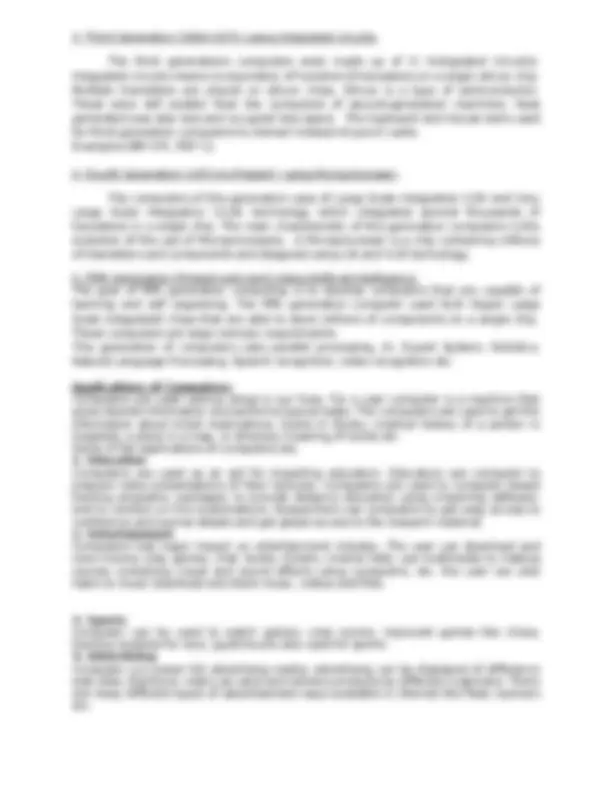
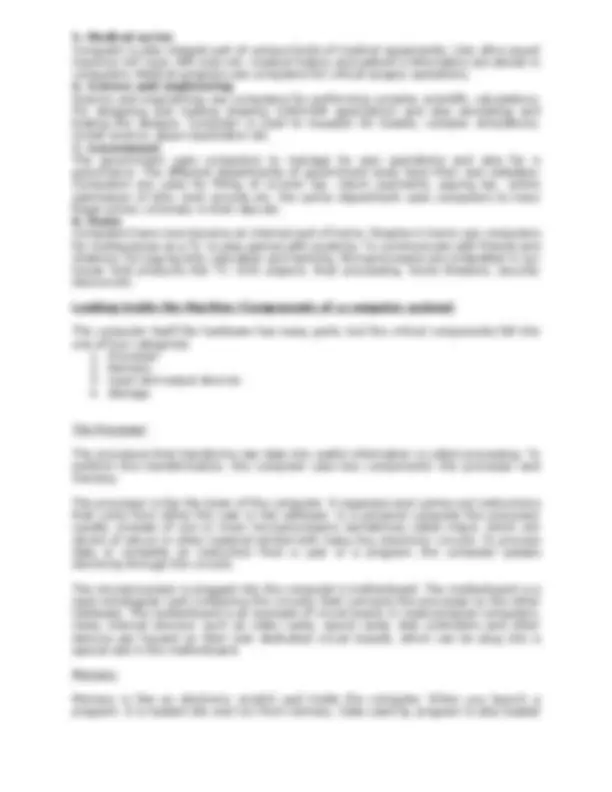
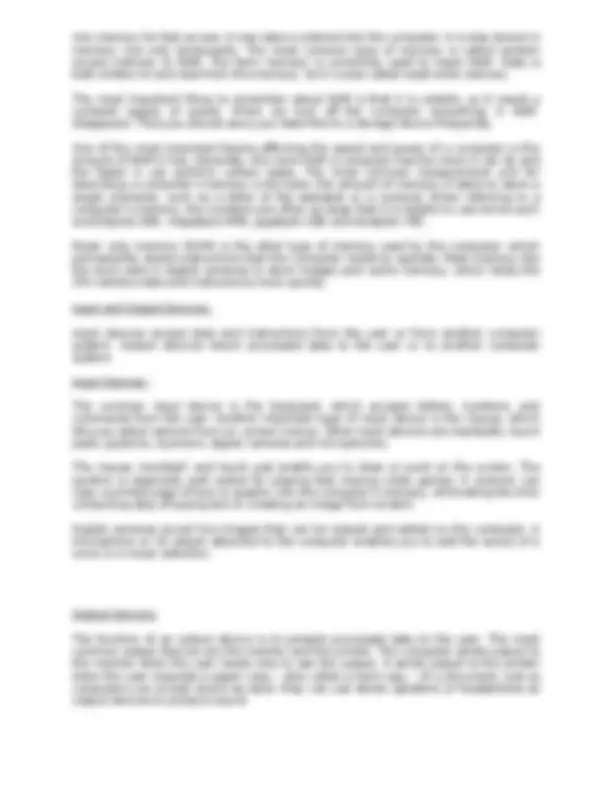
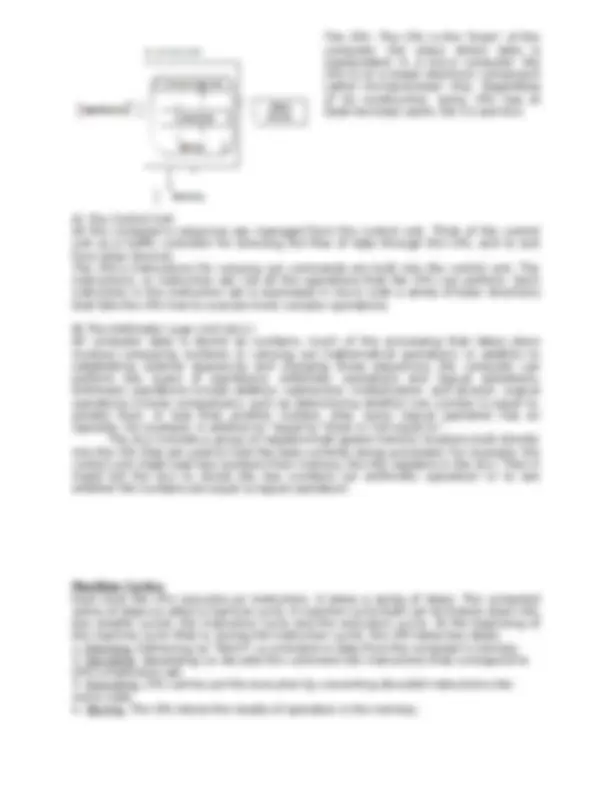
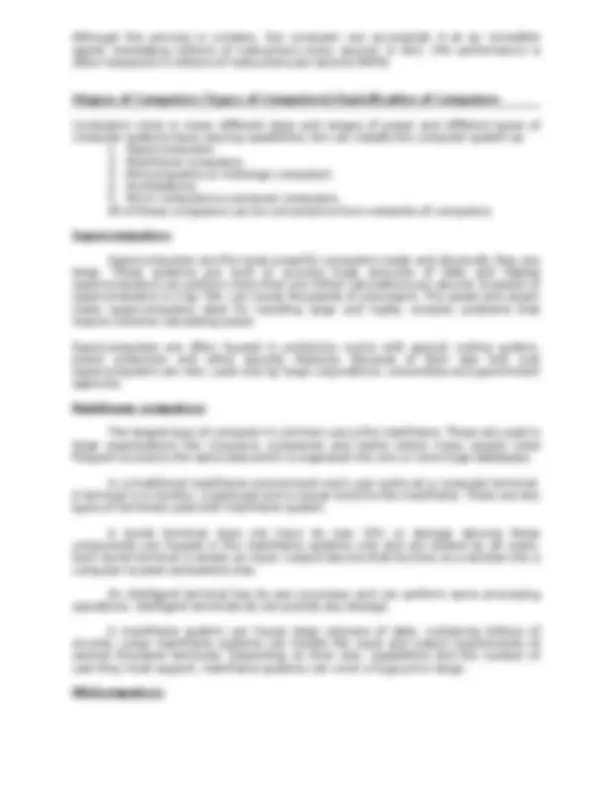
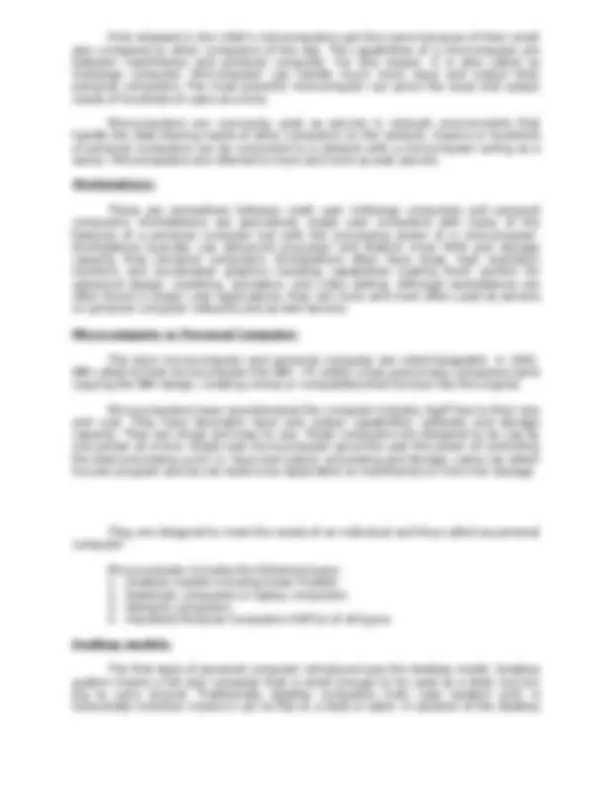
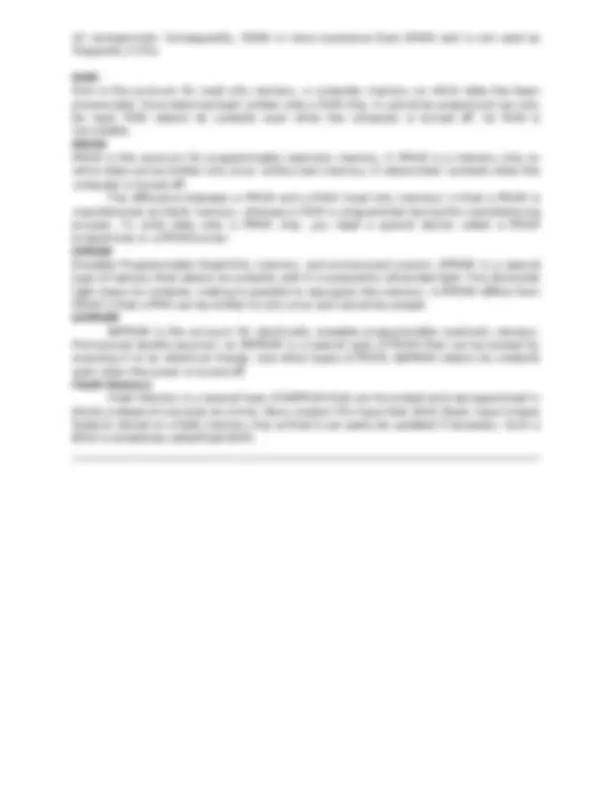


Study with the several resources on Docsity

Earn points by helping other students or get them with a premium plan


Prepare for your exams
Study with the several resources on Docsity

Earn points to download
Earn points by helping other students or get them with a premium plan
Community
Ask the community for help and clear up your study doubts
Discover the best universities in your country according to Docsity users
Free resources
Download our free guides on studying techniques, anxiety management strategies, and thesis advice from Docsity tutors
BBA Computer Application management
Typology: Lecture notes
1 / 13

This page cannot be seen from the preview
Don't miss anything!









On special offer
Unit-1 Introduction to Computer Systems The parts of a computer system: A computer is an electronic device that processes data, converting it into information that is useful to people. The computer is controlled by programmed instructions, which give the machine a purpose and user defined task. A computer may be defined as a machine that can solve problems by accepting user data, performing certain operations and presenting the results. A complete computer system consists of four parts: hardware, software, one or more users and data. Hardware: The physical devices that make up the computer are called hardware. Hardware is any part of the computer you can touch. Computers hardware consists of interconnected electronic devices that you can use to control the computer’s operation, input and output. (The generic term device refers to any piece of hardware). Software: Software is a set of instructions that make the computer perform tasks. In other words software tells the computer what to do. Some programs exist primarily for the computers use helping it perform tasks and manage its own resources. Other types of programs exist for the user, enabling him or her to perform tasks such as creating documents. (The term program refers to any piece of software). Users: People are the computer operators, also known as users. It can be argued that some computer systems are complete without a person’s involvement; however no computer is totally autonomous. Data: Data consists of individual facts or bits of information. The computer reads and stores data of all kinds whether words, numbers, images or sounds in the form of numbers. Consequently, computerized data is digital, meaning that it has been reduced to digits or numbers. Following instructions from the software and the user the computer manipulates data by performing calculations, doing comparisons or arranging the bits of information so they make sense to the user. Within the computer data is organized into files. A file is simply a set of data that has been given a name. A file that the user can open and use is often called a document. Characteristics of Computer:
computer is. 32-bit computer means- computer can process 32 bits at a time. Word length is a measure of computing power of a computer.
5. Medical sector Computer is also integral part of various kinds of medical equipments. Like ultra sound machine CAT scan, MRI scan etc. medical history and patient’s information are stored in computers. Medical surgeons use computers for critical surgery operations. 6. Science and engineering Science and engineering use computers for performing complex scientific calculations. For designing and making drawing (CAD/CAM application) and also simulating and testing the designs. Computer is used to visualize 3d models, complex simulations, rocket science, space exploration etc. 7. Government The government uses computers to manage its own operations and also for e governance. The different departments of government body have their own websites. Computers are used for filling of income tax, return payments, paying tax, online submission of bills, land records etc. the police department uses computers to trace finger prints, criminals, in their labs etc. 8. Home Computers have now become an internal part of home. Peoples in home use computers for multipurpose as a TV, to play games with joysticks. To communicate with friends and relatives. For paying bills, education and learning. Microprocessors are embedded in our house hold products like TV, DVD players, food processing, home theatres, security devices etc. Looking inside the Machine (Components of a computer system) The computer itself the hardware has many parts, but the critical components fall into one of four categories 1. Processor 2. Memory 3. Input and output devices 4. Storage The Processor The procedure that transforms raw data into useful information is called processing. To perform this transformation, the computer uses two components: the processor and memory. The processor is like the brain of the computer. It organizes and carries out instructions that come from either the user or the software. In a personal computer the processor usually consists of one or more microprocessors (sometimes called chips), which are slivers of silicon or other material etched with many tiny electronic circuits. To process data or complete an instruction from a user or a program, the computer passes electricity through the circuits. The microprocessor is plugged into the computer’s motherboard. The motherboard is a rigid rectangular card containing the circuitry that connects the processor to the other hardware. The motherboard is an example of circuit board. In most personal computers, many internal devices- such as video cards, sound cards, disk controllers and other devices are housed on their own dedicated circuit boards, which can be plug into a special slot in the motherboard. Memory: Memory is like an electronic scratch pad inside the computer. When you launch a program, it is loaded into and run from memory. Data used by program is also loaded
into memory for fast access. A new data is entered into the computer; it is also stored in memory- but only temporarily. The most common type of memory is called random access memory or RAM. The term memory is commonly used to mean RAM. Data is both written to and read from this memory. So it is also called read/ write memory. The most important thing to remember about RAM is that it is volatile, so it needs a constant supply of power. When we turn off the computer everything in RAM disappears. Thus you should save your data files to a storage device frequently. One of the most important factors affecting the speed and power of a computer is the amount of RAM it has. Generally, the more RAM a computer has the more it can do and the faster it can perform certain tasks. The most common measurement unit for describing a computer’s memory is the byte- the amount of memory it takes to store a single character, such as a letter of the alphabet or a numeral. When referring to a computer’s memory, the numbers are often so large that it is helpful to use terms such as kilobytes (KB), megabyte (MB), gigabyte (GB) and terabyte (TB). Read- only memory (ROM) is the other type of memory used by the computer, which permanently stores instructions that the computer needs to operate; flash memory like the kind used in digital cameras to store images and cache memory, which helps the CPU retrieve data and instructions more quickly. Input and Output Devices: Input devices accept data and instructions from the user or from another computer system. Output devices return processed data to the user or to another computer system. Input Devices: The common input device is the keyboard, which accepts letters, numbers, and commands from the user. Another important type of input device is the mouse, which lets you select options from on- screen menus. Other input devices are trackballs, touch pads, joysticks, scanners, digital cameras and microphones. The mouse, trackball, and touch pad enable you to draw or point on the screen. The joystick is especially well suited for playing fast moving video games. A scanner can copy a printed page of text or graphic into the computer’s memory, eliminating the time consuming step of typing text or creating an image from scratch. Digital cameras record live images that can be viewed and edited on the computer. A microphone or CD player attached to the computer enables you to add the sound of a voice or a music selection. Output Devices: The function of an output device is to present processed data to the user. The most common output devices are the monitor and the printer. The computer sends output to the monitor when the user needs only to see the output. It sends output to the printer when the user requests a paper copy – also called a hard copy – of a document, just as computers can accept sound as input, they can use stereo speakers or headphones as output devices to produce sound.
System software: System software tells the computer how to use its components. This controls the working of the computer system. Example is operating system, windows 2000, NT, Macintosh, UNIX, LINUX OS/2 and DOS. Operating System: When we turn on a computer, it goes through several steps to prepare itself for use. The first step is called the power – on self test (POST). The computer identifies the devices attached to it, identifies the amount of memory available and does a check to see whether the memory is functioning properly. This initiated by a part of the system software located in read- only memory (ROM), a chip that contains brief, permanent instructions for starting the computer. Next the computer looks for an OS, which is usually stored on the hard disk. The OS tells the computer how to interact with the user and how to interact with the user and how to use devices such as the disk drives, keyboard, and monitor. When it finds the OS, the computer loads a portion of it into memory. Because the OS is necessary for controlling the computer’s most basic functions, it continues to run until the computer is turned off. After the computer finds and runs the OS, it is ready to accept commands from an input device- usually the keyboard or a mouse – or from a program. At this point, the user can issue commands to the computer. Application Software: This tells the computer how to accomplish specific tasks such as word processing or drawing for the users. Programs that help people accomplish specific tasks are referred to as application software. Ex: Microsoft word, Corel Draw AutoCAD etc. A special type of application software is called utility software, helps us to fine tune the performance of a computer, prevent unwanted actions, or perform special, system – related tasks such as checking for viruses or sending a fax. Some of the computer applications are,
The CPU: The CPU is the "brain" of the computer, the place where data is manipulated. In a micro computer, the CPU is on a single electronic component called microprocessor chip. Regardless of its construction, every CPU has at least two basic parts: the CU and ALU A). the Control Unit All the computer's resources are managed from the control unit. Think of the control unit as a traffic controller for directing the flow of data through the CPU, and to and from other devices. The CPU's instructions for carrying out commands are built into the control unit. The instructions, or instruction set, list all the operations that the CPU can perform. Each instruction in the instruction set is expressed in micro code a series of basic directions that tells the CPU how to execute more complex operations. B).The Arithmetic Logic Unit (ALU.) All computer data is stored as numbers, much of the processing that takes place involves comparing numbers or carrying out mathematical operations. In addition to establishing ordered sequences and changing those sequences, the computer can perform two types of operations: arithmetic operations and logical operations. Arithmetic operations include addition, subtraction, multiplication, and division. Logical operations include comparisons, such as determining whether one number is equal to, greater than, or less than another number. Also, every logical operation has an opposite. For example, in addition to "equal to" there is "not equal to." The ALU includes a group of registers-high-speed memory locations built directly into the CPU that are used to hold the data currently being processed. For example, the control unit might load two numbers from memory into the registers in the ALU. Then it might tell the ALU to divide the two numbers (an arithmetic operation) or to see whether the numbers are equal (a logical operation). Machine Cycles Each time the CPU executes an instruction, it takes a series of steps. The computed series of steps is called a machine cycle. A machine cycle itself can be broken down into two smaller cycles: the instruction cycle and the execution cyc1e. At the beginning of the machine cycle (that is, during the instruction cycle), the CPU takes two steps:
Fetching. Retrieving (or "fetch") a command or data from the computer's memory.
Decoding. Separating (or decode) the command into instructions that correspond to CPU’s instruction set.
Executing. CPU carries out the execution by converting decoded instructions into micro code.
Storing. The CPU stores the results of operation in the memory.
First released in the 1960’s minicomputers got this name because of their small size compared to other computers of the day. The capabilities of a minicomputer are between mainframes and personal computer. For this reason, it is also called as midrange computer. Minicomputer can handle much more input and output than personal computers. The most powerful minicomputer can serve the input and output needs of hundreds of users at a time. Minicomputers are commonly used as servers in network environments that handle the data sharing needs of other computers on the network. Dozens or hundreds of personal computers can be connected to a network with a minicomputer acting as a server. Minicomputers are referred to more and more as web servers. Workstations: These are somewhere between multi user midrange computers and personal computers. Workstations are specialized, single user computers with many of the features of a personal computer but with the processing power of a minicomputer. Workstations typically use advanced processor and feature more RAM and storage capacity than personal computers. Workstations often have large, high resolution monitors and accelerated graphics handling capabilities making them perfect for advanced design, modeling, animation, and video editing. Although workstations are often found in single- user applications, they are more and more often used as servers on personal computer networks and as web servers. Microcomputer or Personal Computer: The term microcomputer and personal computer are interchangeable. In 1981, IBM called its first microcomputer the IBM – PC within a few years many companies were copying the IBM design, creating clones or compatibles that function like the original. Microcomputers have revolutionized the computer industry itself due to their size and cost. They have favorable input and output capabilities, software and storage capacity. They are cheap and easy to use. These computers are designed to be use by one person at a time. Single user microcomputer gives the user the power of controlling the total processing cycle i.e. input and output, processing and storage, users can select his own program and do not need to be dependent on mainframes or mini’s for storage. They are designed to meet the needs of an individual and thus called as personal computer. Microcomputer includes the following types:
system is the tower model where the system unit sits vertically and has more space for devices. Notebook computers: Notebook computers as their name implies, approximate the shape of an 8.5 by 11 inch notebook and can fit inside a brief case easily. This can operate on alternating (plug – in) current or special batteries. These are fully functional microcomputers. Because of their size, notebook computers feature a smaller display, less memory and less storage space than a full size PC. These are also available with the same processing power of the most powerful full sized PCs. Network Computers: In some situations user does not need all the power and feature provided by a PC. For example, if we want to use only to interact or if our job involves data entry then we may not need the processing power, memory and storage capacity of a fully equipped PC. In these situations network computers become useful. Network computer is a less powerful version of a PC with minimal processing power and storage. Network computers are designed to be connected for a network, a corporate intranet, or to the internet. A popular example of a home based network computer is web TV, which enables the user to connect a television to the internet and enjoy both standard television programming and internet service. Advantages are:
10 nanoseconds. Consequently, SRAM is more expensive than DRAM and is not used as frequently in PCs. ROM Rom is the acronym for read only memory, a computer memory on which data has been prerecorded. Once data has been written onto a ROM chip, it cannot be erased and can only be read. ROM retains its contents even when the computer is turned off. So ROM is nonvolatile. PROM PROM is the acronym for programmable read-only memory. A PROM is a memory chip on which data can be written only once. Unlike main memory, it retains their contents when the computer is turned off. The difference between a PROM and a ROM (read only memory) is that a PROM is manufactured as blank memory, whereas a ROM is programmed during the manufacturing process. To write data onto a PROM chip, you need a special device called a PROM programmer or a PROM burner. EPROM Erasable Programmable Read-Only memory, and pronounced e-prom, EPROM is a special type of memory that retains its contents until it is exposed to ultraviolet light. The ultraviolet light clears its contents, making it possible to reprogram the memory. A EPROM differs from PROM in that a PRM can be written to only once and cannot be erased. EEPROM EEPROM is the acronym for electrically erasable programmable read-only memory. Pronounced double ee-prom, an EEPROM is a special type of PROM that can be erased by exposing it to an electrical charge. Like other types of PROM, EEPROM retains its contents even when the power is turned off. Flash Memory Flash Memory is a special type of EEPROM that can be erased and reprogrammed in blocks instead of one byte at a time. Many modern PCs have their BIOS (Basic Input Output System) stored on a flash memory chip so that it can easily be updated if necessary. Such a BIOS is sometimes called flash BIOS.